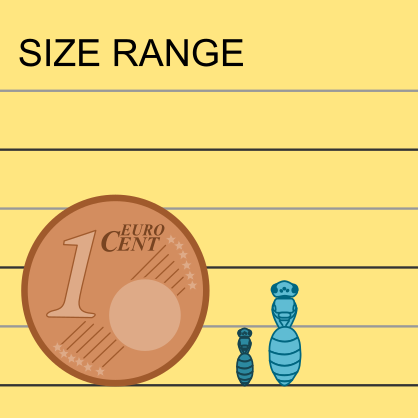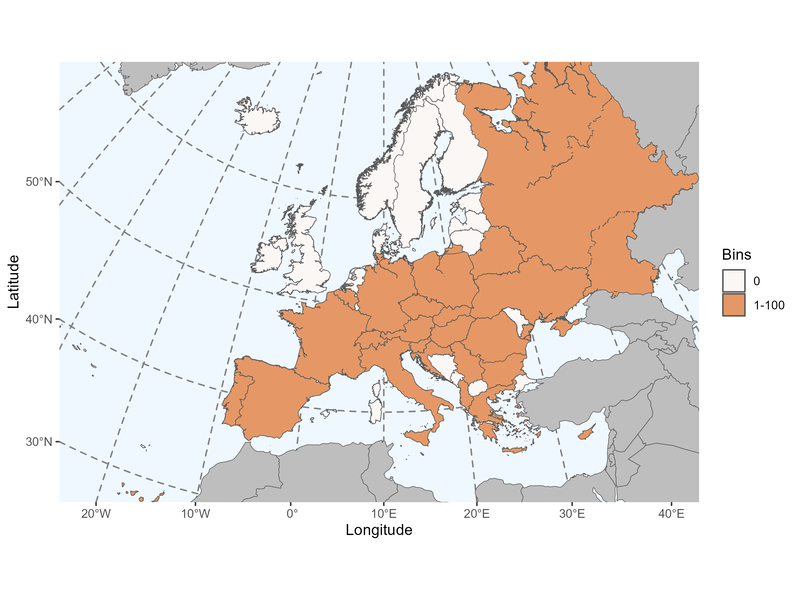Author: Latreille, 1809
|
Type species: Ammobates rufiventris Latreille, 1809, by designation of Latreille, 1810.
Subgenera: Ammobates s. str. Latreille, 1809; Euphileremus Popov, 1951. Synonyms: Phileremus Latreille, 1809; Ammobatoides Schenck, 1869 (not Radoszkowski 1867); |
Clade: Anthophila
Family: Apidae Subfamily: Nomadinae Tribe: Ammobatini |
|
Distinctive traits
|
Pictures of distinctive traits
|
Morphologically close genera, and how to distinguish them:
Biastes species have a short and wide scapus, less than twice as long as wide. Females have a clear propodeal triangle and a bidentate mandible. Males have a labrum wider than long.
Ammobates species have a protruding metanotum, sternite 5 surrounds only partially the basal part of sternite 6, sternite 6 is short and bidentate. Males have 13-segmented antennae.
Pasites species have a flat metanotum, sternite 5 surrounds entirely the basal part of sternite 6, sternite 6 is long and sting-like. Males have 12-segmented antennae.
Parammobatodes have mandibles crossing before their apices, forming an angle smaller than 145°. The first recurrent vein joins submarginal cell 2 after the middle of its posterior margin.
Clavipanurgus, Flavipanurgus, Panurginus, Panurgus & Simpanurgus species have a flat clypeus and a short-tongue morphology of mouthparts (short maxillary palpi).
Ammobatoides & Schmiedeknechtia species have an oval or pointed marginal cell, basal part of submarginal cell 1 is around twice as long as that of submarginal cell 2. Males have strongly converging eyes.
- Ammobates - Biastes
Biastes species have a short and wide scapus, less than twice as long as wide. Females have a clear propodeal triangle and a bidentate mandible. Males have a labrum wider than long.
- Ammobates - Pasites
Ammobates species have a protruding metanotum, sternite 5 surrounds only partially the basal part of sternite 6, sternite 6 is short and bidentate. Males have 13-segmented antennae.
Pasites species have a flat metanotum, sternite 5 surrounds entirely the basal part of sternite 6, sternite 6 is long and sting-like. Males have 12-segmented antennae.
- Ammobates - Parammobatodes
Parammobatodes have mandibles crossing before their apices, forming an angle smaller than 145°. The first recurrent vein joins submarginal cell 2 after the middle of its posterior margin.
- Ammobates - Clavipanurgus, Flavipanurgus, Panurginus, Panurgus & Simpanurgus
Clavipanurgus, Flavipanurgus, Panurginus, Panurgus & Simpanurgus species have a flat clypeus and a short-tongue morphology of mouthparts (short maxillary palpi).
- Ammobates - Ammobatoides & Schmiedeknechtia
Ammobatoides & Schmiedeknechtia species have an oval or pointed marginal cell, basal part of submarginal cell 1 is around twice as long as that of submarginal cell 2. Males have strongly converging eyes.
General comments on Ammobates species identification
Species identification requires microscopic study of maxillary palps, thorax punctation, micropilosity, last sternites and genitalia in males.
Species identification requires microscopic study of maxillary palps, thorax punctation, micropilosity, last sternites and genitalia in males.
Sorry, but the species identification tool is not yet available for Ammobates.
Please check the reference(s) at the bottom of the page for traditional keys.
Please check the reference(s) at the bottom of the page for traditional keys.
List of the 14 Ammobates species found in Europe (Ghisbain et al. 2023):
Ammobates (Ammobates) armeniacus Morawitz, 1876
Ammobates (Ammobates) biastoides (Friese, 1895)
Ammobates (Ammobates) dusmeti Popov, 1951
Ammobates (Ammobates) mavromoustakisi Popov, 1944
Ammobates (Ammobates) opacus Popov, 1951
Ammobates (Ammobates) punctatus (Fabricius, 1804)
Ammobates (Ammobates) rufiventris Latreille, 1809
Ammobates (Ammobates) sanguineus Friese, 1911
Ammobates (Ammobates) similis Mocsáry, 1894
Ammobates (Ammobates) verhoeffi Mavromoustakis, 1959
Ammobates (Ammobates) vinctus Gerstaecker, 1869
Ammobates (Euphileremus) melectoides (Smith, 1854)
Ammobates (Euphileremus) muticus Spinola, 1843
Ammobates (Euphileremus) oraniensis (Lepeletier, 1841)
Ammobates (Ammobates) armeniacus Morawitz, 1876
Ammobates (Ammobates) biastoides (Friese, 1895)
Ammobates (Ammobates) dusmeti Popov, 1951
Ammobates (Ammobates) mavromoustakisi Popov, 1944
Ammobates (Ammobates) opacus Popov, 1951
Ammobates (Ammobates) punctatus (Fabricius, 1804)
Ammobates (Ammobates) rufiventris Latreille, 1809
Ammobates (Ammobates) sanguineus Friese, 1911
Ammobates (Ammobates) similis Mocsáry, 1894
Ammobates (Ammobates) verhoeffi Mavromoustakis, 1959
Ammobates (Ammobates) vinctus Gerstaecker, 1869
Ammobates (Euphileremus) melectoides (Smith, 1854)
Ammobates (Euphileremus) muticus Spinola, 1843
Ammobates (Euphileremus) oraniensis (Lepeletier, 1841)
References with identification keys for some of the species:
- Osytshnjuk, A.Z., Panfilov, D.V. & Ponomareva A.A. (1978) Superfamily Apoidea. In: Tobias, V.I. (Ed). Key to the insects of European part of the USSR. Vol. 3. Hymenoptera. Pt. 1. Nauka, Leningrad, 279-519. (In Russian)
- Amiet F., Herrmann M., Müller A. & Neumeyer R., 2007. Apidae 5. Ammobates, Ammobatoides, Anthophora, Biastes, Ceratina, Dasypoda, Epeoloides, Epeolus, Eucera, Macropis, Melecta, Melitta, Nomada, Pasites, Tetralonia, Thyreus, Xylocopa. Fauna Helvetica 20. Centre suisse de cartographie de la faune (CSCF), Neuchâtel, 356 pp.
Page contributors:
You noticed a mistake? You have a suggestion to improve this page?
Don't keep it to yourself, contact us and become a contributor to IDmyBee!
References used to write this page:
- Adrien Perrard (Dec. 2023)
- Adrien Perrard (Dec. 2019)
You noticed a mistake? You have a suggestion to improve this page?
Don't keep it to yourself, contact us and become a contributor to IDmyBee!
References used to write this page:
- Ghisbain, G., Rosa, P., Bogusch, P., Flaminio, S., Le Divelec, R., Dorchin, A., Kasparek, M., Kuhlmann, M., Litman, J., Mignot, M., Müller, A., Praz, C., Radchenko, V.G., Rasmont, P., Risch, S., Roberts, S.P.M., Smit, J., Wood, T.J., Michez, D. & Reverte, S. (2023). The new annotated checklist of the wild bees of Europe (Hymenoptera: Anthophila). Zootaxa, 5327(1), 1-147.
- Michener, C.D. 2007. The Bees of the World, 2nd Edition. The John Hopkins University Press, Baltimore.
- Michez D., Rasmont P., Terzo, M., Vereecken, N. 2019. Abeilles d'Europes. Hymenoptères d'Europes, Volume 1. N.A.P. Editions.
- Nieto, A., Roberts, S. P., Kemp, J., Rasmont, P., Kuhlmann, M., García Criado, M., ... & Michez, D. 2014. European red list of bees. Luxembourg: Publication Office of the European Union, 98. (IUCN 2014)
- Rasmont, P., Devalez, Jelle, Pauly, A., Michez, D. & Radchenko, V.G. 2017. Addition to the checklist of IUCN European wild bees (Hymenoptera: Apoidea). Annales de la Société entomologique de France 53: 17-32.



